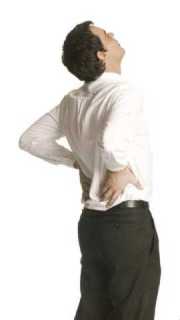>
I had been suffering from back pain for a while, but this didn’t prevent me from continuing with my regular activities. A bad day when playing football, I was sure I had suffered from a herniated disc. I rested in bed, but it was getting worse and I eventually was advised to undergo surgery. So I did. I was extracted a large extruded disc. It all went well… for about 5 years. Then everything went from bad to worse with prolonged periods of taking for sick leaves, immobilized in bed. It has been about 20 years since then.
Body movement was very limited by pain and stiffness. Getting in and out of the car, sitting down, turning around or putting my socks on each morning was difficult and painful.
And so on for several years, taking sick leaves one or two months a year, confined to bed. The scanner showed postoperative changes, fibrosis and degenerative changes. The neurosurgeon took for granted that my column would be unstable and spoke of “installing some metals” …
It was then when I discovered that my enemy was the rest and that movement would get me out of that situation. It was clear that any attempt to do something would activate pain on the spine. I thought there was a “pinched” nerve root, contractured muscles, arthritis, fibrosis … enough conditions to justify the pain. I still had Descartes in mind and assumed that pain arose from where I was feeling it, from the spine.
Through simple movements in various positions and getting rid of fear, convincing myself that nothing bad would happen, each day I started regaining more and more mobility in the joints. At the same time, I gathered information about pain, depression, anxiety, neurophysiology… One question led me to another. Necrosis, apoptosis, inflammation, tissue repair, evolution, perception, efferent copy, reward systems, hypervigilance, mirror neurons, pain memory, nociception, culture.
I inadvertently changed my whole mindset. I stopped being Cartesian. I discovered that pain wasn’t coming from the spine, but from my brain. Each movement was evaluated and programmed by the brain. I would only express my desire to get up and my brain would do the rest. If my desire to turn, bend or stand up was rated as threatening, a defensive-deterrent program was activated. If the brain didn’t see it as a threat, it could achieve the purpose with a suitable, articulated program without hesitation.
At first I needed some kind of ritual. I would sit on a kitchen chair in hyperlordosis and stretch my head toward the ceiling as if it would make some nerve unpinch. Within seconds I felt the lower back had relaxed. Other times it was not enough and I had to lie down and make a series of moves to free the lumbar joints, hips … Occasionally limitations of the past reappeared to a lesser degree: cramps, lashes, stiffness… I had to take extreme care to avoid flexing the spine when lifting weights, sitting straight forcing the lumbar curvature (lordosis) … Some days were better, others worse, but I never took a sick leave again. Over the years everything has dissolved. I feel the way I want to feel, I lift weights without thinking about how I should be doing it, I have forgotten the “good postures” and I make a normal life with no restrictions.
Ten years ago I began to shape all these changes in my beliefs and knowledge and then it was time for action with those who suffered from migraine. Until then I used to tell them what I had been taught to tell (genes and triggers), prescribed what I had been taught to prescribe (antidepressants, beta blockers …). When the triptans and anticonvulsants came by I was already a convicted infidel. I had replaced drugs with by talks, therapy with education. Then fibromyalgia and chronic fatigue syndrome (myalgic encephalitis) came by. I read an article by Simon Wessely on cognitive therapy and found the transcendence of information, beliefs and expectations and the angry reactions of the sufferer communities.
Later came the theory of information, signals, noise, processing, Bayes, neuronal networks.
Just a bit before publishing my first book, Jaqueca, análisis neurobiológico de un dolor irracional in 2004 (Headache, a neurobiological analysis of an irrational pain) I read an article by a man named Lorimer Moseley and, later, when I was into neurobiopedagogy, I read his book Explain Pain. Moseley’s book freed me from feeling the burden of a preacher in the desert alone, and recently, the appearance of the SEFID (Spanish Society of Physiotherapy and Pain) made me feel a member of a group of therapists (including my daughter and my son-in-law) with lots of shared convictions, absolutely passionate about the biology of pain, tissues and neurons.
I had a really bad time during the “spine years”. There was no horizon. Only pain, numbness, fear, despair, inability … The “brain years” have released me from that hell.
And here I am now, trying to show new beliefs to sufferers, with varying luck.
– I’m not convinced … You say that pain does not exist … that’s in my mind … it hurts because I think it’ll hurt … that it’s psychological … but I have been detected several herniated discs, arthritis, osteoporosis, grips by Resonances, my physiotherapist told me that I have many contractions, stress… I go to a back training school …
From what is brought up, it’s believed and from what is believed, it’s created. At least that’s the way it is for lots of spine pain cases.

